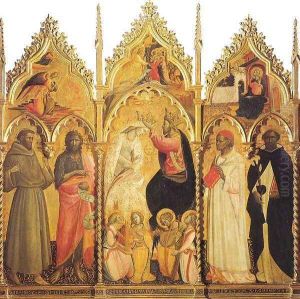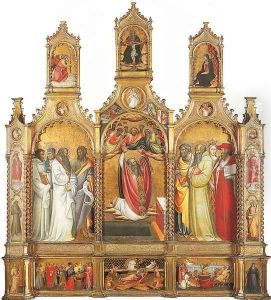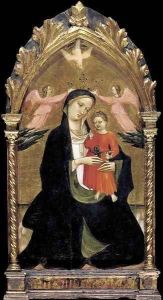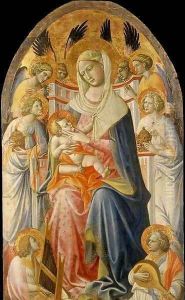Giovanni del Ponte (also known as Giovanni di Marco) Paintings
Giovanni del Ponte, also known as Giovanni di Marco, was an Italian painter of the early Renaissance period. Born in 1385 in Florence, he was a contemporary of notable artists such as Masaccio and Fra Angelico. His nickname 'del Ponte' derives from his grandfather's house 'by the bridge' (ponte in Italian), which was located near the Ponte Vecchio in Florence.
Giovanni's training and early influences are not thoroughly documented, but it is believed that he may have been a pupil of the Florentine master Spinello Aretino, who was known for his narrative frescoes and a vivid use of color. Giovanni del Ponte's style also suggests that he was familiar with the works of Lorenzo Monaco and the International Gothic style, which was characterized by elegant and refined figures and decorative patterns.
Throughout his career, Giovanni del Ponte was active primarily in Florence and its surroundings, where he worked on altarpieces, frescoes, and other religious commissions. His works often featured religious scenes, including depictions of the Virgin Mary, saints, and scenes from the life of Christ. He was particularly skilled in portraying narrative scenes with multiple figures and displayed a preference for bright, clear colors and attention to detail.
Some of Giovanni del Ponte's notable works include a series of frescoes for the church of San Stefano al Ponte in Florence, which unfortunately were later destroyed, and an altarpiece for the church of Santa Trinita, also in Florence. His paintings are characterized by their serene and graceful figures set against gold backgrounds, a common trait in Gothic art of the period.
Despite his considerable output and the quality of his work, Giovanni del Ponte did not achieve the same level of fame as some of his contemporaries. His death in 1437 marked the end of his contributions to the Florentine art scene. However, his works can still be seen in various museums and churches, where they continue to be appreciated for their charm and historical significance within the context of the early Renaissance.



